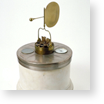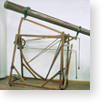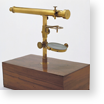In the 18th and 19th centuries the production of precision instruments for astronomy, geodetics, surveying and navigation was concentrated mainly in Britain, France and Germany. The British instrument maker Jesse Ramsden (1735-1800) invented the first machine for precisely dividing graduated scales. In Bavaria, Joseph von Fraunhofer (1787-1826) produced the finest optical-quality glass ever made. In Italy, only Giovanni Battista Amici (1786-1863) was able to design original optical instruments, many of them displayed in this room. They include excellent microscopes and exceptionally long telescopes. These innovations went to improve the instrumentation of the astronomical observatories founded in Italy starting from the first decades of the 18th century. The Florence Observatory (1780-1789), annexed to the Museum of Physics and Natural History, aspired to compete with the great astronomical centres of Greenwich and Paris. It was equipped mainly with instruments of British make.
Meteorology
Over the course of the 18th century the study of meteorology assumed growing importance. Instruments for measuring such atmospheric phenomena as pressure, ...
(9 objects)
Telescopes for Astronomical Observatories
During the 18th century, in addition to refractors, reflecting telescopes featuring a concave metal mirror in place of the objective lens came into common ...
(8 objects)
Perfecting Microscopes
In the 19th century many new optical instruments were invented and the existing ones were improved, thanks to continuous progress in fabricating optical-quality ...












